 |
FLEX OFFENSE
Back in the 1970's, an offense was developed as an even-guard front version of
the shuffle offense known today as the Flex offense. This offense has found its success replicated in the
international, professional, collegiate, and amateur ranks as an offense that is
difficult to stop and takes advantage of the defense's mistakes.
Advantages of the Flex Offense
The Flex offense is difficult to guard when the offense is able to make the
guard-to-guard pass on top. This is because of how difficult the
screen-the-screener action is to defend. Reversing the basketball makes
defenses work and the guard-to-guard pass must be denied. When this
happens, there are several counters that the offense can use to take advantage
of a single-minded defense.
The second aspect of the Flex offense that is advantageous is that it can be
incorporated as a quick hitter or as an inbounds play. Several teams have
found how they can flow into the offense and use it to execute the offense,
especially the baseline cut.
Third, there is a counter for everything. If the defense takes something
away, the way the defense plays against the offense can be exploited for a big
score. As mentioned earlier, if the defense tries to take away one thing,
the offense has an answer.
Disadvantages of the Flex Offense
In most cases, the offense requires that all five players play all five
positions. While there are variations of the Flex offense that can be run
to compensate for this, the primary way that the Flex offense is run requires
all players to be capable cutters, screeners, passers, and jump shooters.
All of these things have to be worked on during practice.
Another disadvantage is that the offense, because its patterned, players can
become so focused on trying to get the basic movement to work that they can
forget about the counters. It is important that the players be put in
positions in practice where they are forced to run the counters against a live
defense.
Basic Movement
Diagram 1 shows the first action in the basic movement of the Flex offense.
On any pass from guard to guard, the post on the first side of the floor sets a
back screen for the player in the corner. Meanwhile, the post on the side
opposite the occupied corner will pop out to the new ball-side corner.
Diagram 2 shows the second part of the basic movement. Once the cutter
uses the screen the player who made the guard-to-guard pass in the first diagram
will set a down screen for the screener from the first diagram. This
assumes that the defense did not switch the first screen for which there is a
counter that will be presented later in the article.
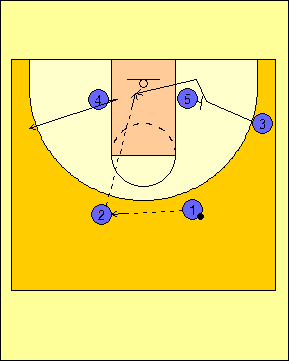
Diagram
1 |
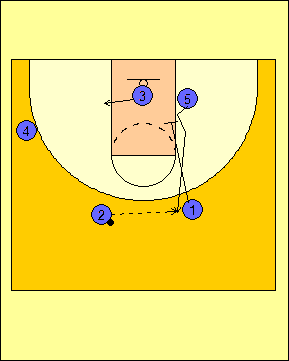
Diagram
2 |
Diagrams 3 and 4 show the basic movements of the Flex offense going from the
second side to the third side of the floor.
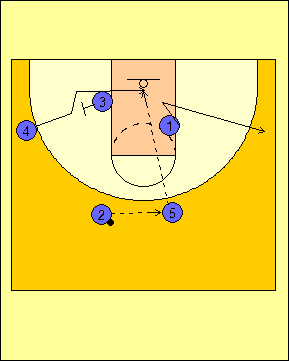
Diagram
3 |
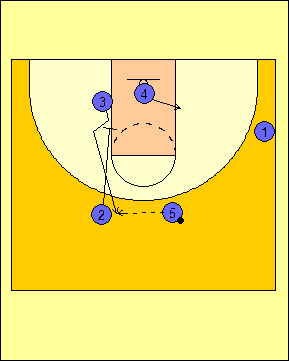
Diagram
4 |
Flex Offense Counters
The Flex offense has several counters that have to
be taught to the players so that the offense can take advantage of
the defense taking away parts of the offense. Diagram 5 shows
what we do when the defense anticipates the down screen for the
first screener in the basic movement. We will have the cutter
off of the down screen use the screen again. This time, it
will be used as a back screen so that we can get the lay-up off of
the defense's cheating the screen.

Diagram
5 |
If the defense anticipates the back screen for the
corner, we set up a stagger double (Diagram 6). The back
screen becomes the first screen in the stagger while the player
making the guard-to-guard pass sets the second screen in the
stagger.
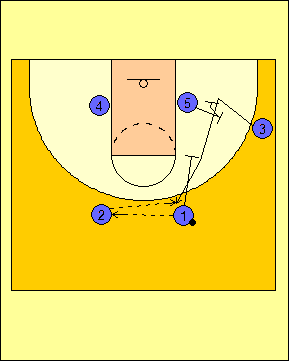
Diagram 6 |
It is also common that the defense will look to
switch screens as shown in Diagram 7. Here, the back screen
for the corner is switched. When this happens, we want the
screener to turn and step to the ball and receive the pass.
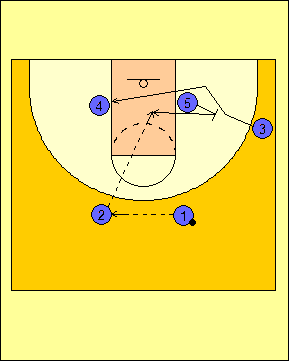
Diagram 7 |
The defense could also switch on the down screen as
shown in Diagram 8. When this happens, we want the screener to
slip to the basket and look for the lay-up.

Diagram
8 |
If the pass cannot be made to the guard or the
corner, the help-side post can then flash to the high post and
receive the pass (Diagram 9). When this happens, the guard
opposite the passer will cut backdoor and look for the lay-up.
In Diagram 10, the backdoor is not available and a
number of options develop. The blind pig can make a high/low
pass, a pass to the original passer who switches sides of the floor,
the back-cutting guard who comes back to the perimeter, or the
remaining player (#3) who v-cuts and replaces.
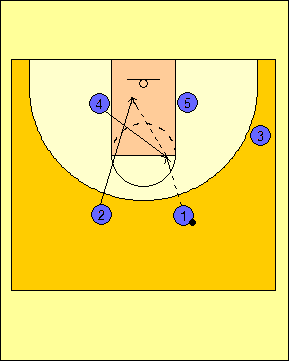
Diagram
9 |
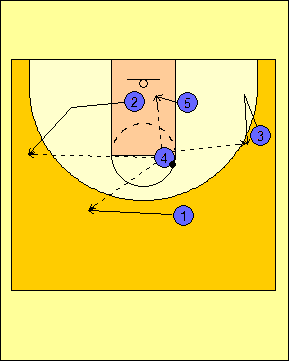
Diagram
10 |
Corner Options
When the ball is passed to the corner, there are
three options that are available. It should be noted that the
coach should only choose one of these options.
The first of these is a UCLA cut as shown in Diagram
11. If the pass cannot be made to the cutter off of the UCLA
cut, the ball can be passed back to the top to the screener or to
the help-side post who comes across on the away screen set by the
player coming off of the UCLA cut (Diagram 12).
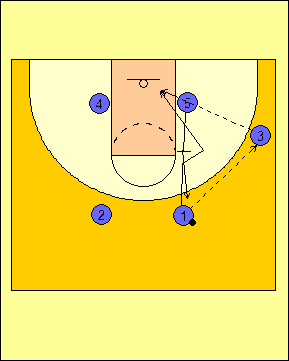
Diagram
11 |
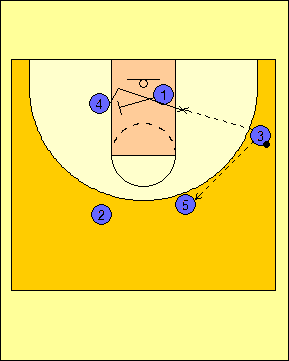
Diagram
12 |
The other option is to keep with the idea of screen-the-screener as the heart of
the Flex offense. In Diagram 13, the ball-side post screens away for the
help-side post and brings him to the ball. After the help-side post
clears, the ball-side guard sets the down screen for the first screener.

Diagram
13 |
The last of these is for the offense to pair off and
screen away as shown in Diagram 14. The players on the ball
side will screen way for the players on the help side. The
ball-side guard will screen away for the help-side guard and the
ball-side post will screen away for the help-side post.
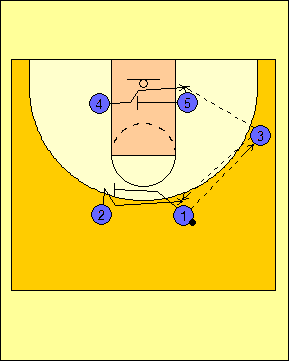
Diagram
14 |
Maryland Flex
The Maryland Flex is a variation of the Flex offense
in that it relies on reversing the basketball and only using the
baseline cut. In Diagrams 15 and 16, the ball is swung from
side to side as the post sets the back screen in each instance for
the baseline cutter. The only difference from the regular Flex
offense is that the down screen is not made by a guard. This
offense works well if you have three forwards and two guards.
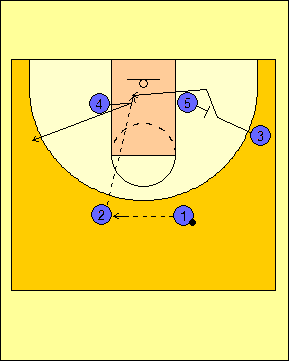
Diagram
15 |
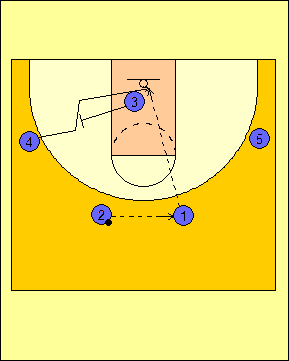
Diagram 16 |
Maryland Flex Counters
In the Maryland Flex, there are times when the
offense will take away the guard-to-guard pass that keeps the
offense going. When that happens, there is a counter that can
take advantage of this development. The defense in Diagram 17
overplays the passing lane. When this happens, the help-side
guard will fake high then cut backdoor and look for the pass.
If the backdoor is not available, the player with
the ball will change sides of the floor with the dribble (Diagram
18).
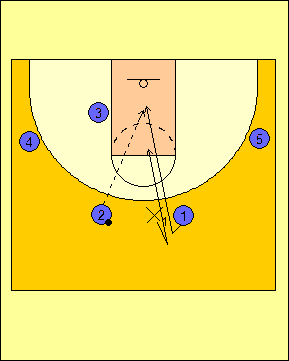
Diagram
17 |

Diagram
18 |
When the counter has been completed, the baseline
cut action resumes. It will restart with a back screen by the
post as the guard looks for the baseline cutter.
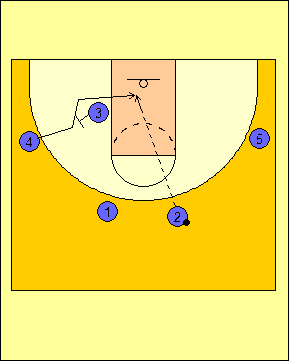
Diagram
19 |
Flex Offense in Transition
When running the Flex offense, the transition game can be put into
practice relatively easily. If the ball is passed ahead to the
corner, the corner option can be executed. Here, the UCLA cut
option to the corner is used in transition in Diagram 20.
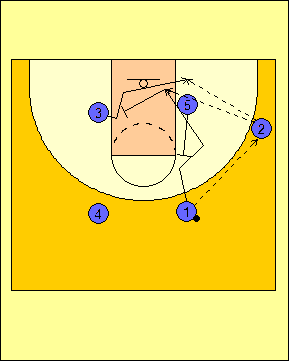
Diagram
20 |
The other option is to make the guard-to-guard pass to the trailer
(Diagram 21). When this happens, we get into the basic Flex
action with the screen-the-screener action for which the Flex
offense is known.
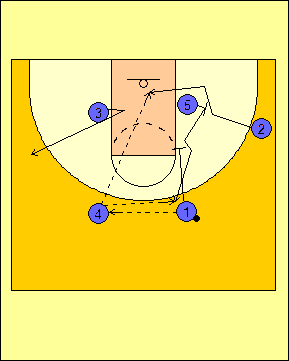
Diagram
21 |
If neither option is possible, we can run a high
pick-and-roll play (Diagram 22). The ball screener will roll to
the basket and get replaced by the post-up man in the transition
offense. Depending on whether the ball is passed to the corner or
reversed, the corner option or the Flex action can be run.

Diagram
22 |
Teaching the Flex Offense
When introducing the Flex offense, it is best to teach the movement with five
offensive players against no defense. This allows the players to learn the
basic movements as well as the counters. It is best to teach the basic
offense then move into the counters once the offense is fully understood by the
players.
There are three breakdown drills that are effective for the Flex offense.
The first is the rear screen drill. This drill works on the baseline cut
in the Flex offense. It starts out two-against-zero so that the movements
and the counter to a switching defense can be taught. We then add the
defense and tell the defense (not letting the offense know) how to handle the
screen. The offensive players should respond according to whether or not
the defense switches to execute the maneuver.
The second drill is the down screen drill. This works on the second screen
in the offense. It should be taught in the same way as the rear screen
drill in that it should start with no defense against it then move to a
two-on-two situation with the defense switching and not switching so that the
offensive players can act accordingly.
The last part of the offensive breakdown is to work on the combination of the
rear screen and the down screen. This drill is four-against-three and
starts with the guard-to-guard pass. Once it is made, the
screen-the-screener action is executed by the offense against a defense that can
either anticipate, switch, or play normal defense.
RETURN TO MEMBERSHIP AREA
© 2010-2017 Alan Peel Enterprises
|
 |